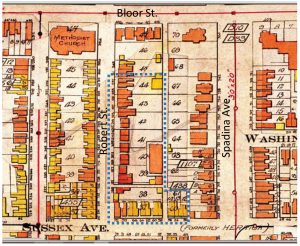Can a park’s past set the tone for its future?

Had the Spadina Expressway been built, there might have been a development like St. James Town west of Yonge Street. The city had rezoned the area, and a developer had quietly purchased many of the 32 properties on Robert and Sussex avenues. COURTESY CITY OF TORONTO ARCHIVES
By Nicholas Provart
Fifty years ago, around the same time that the City of Toronto was planning the Spadina Expressway, urban planners had a bold vision for the area surrounded by Robert Street, Sussex Avenue, Bloor Street, and Spadina Avenue. The thought was to build two tall towers and create another St. James Town. The city rezoned the area, and a developer quietly purchased many of the 32 properties on Robert and Sussex avenues.
The residents who lived in the area, however, were not so quiet. The Sussex Area Residents’ Association responded with an 80-page report detailing their grievances. They highlighted the loss of affordable housing both for students and owners of the houses in the area, increased density, and limited green space. They also underscored the lack of recognition of how the area functioned “in the creation of the Canadian nation”, absorbing successive waves of immigrants.
By June 1967, the rezoning was repealed, and the developers, University of Toronto and City of Toronto agreed to what’s become known as the Aura Lee Transfer.
The city wanted to extend Ramsden Park, between Roxborough and Pears avenues, all the way to Avenue Road. The university’s Aura Lee Playing Field was just east of Avenue Road at the west end of Ramsden Park, and the developer had properties on the south side of Pears Avenue.
Instead of purchasing the playing field, the developer exchanged its Robert Street land for the Aura Lee Playing Field. By 1968, the developer had enough land to build two towers on Pears Avenue, and received permission to build from the city by pledging the northerly 1.6 acres of Aura Lee lands to create the western extension of Ramsden Park.
In 1968-69, deaf to affordable housing concerns, the university tore down 32 houses on Robert Street and Sussex Avenue to create the Robert Street Field. It was well used by the community, and a skating rink and tennis courts were built on the site.
In 1971, the university and the city came to what council called an exemplary agreement: the public would be able to use the facilities and the city would pay the cost of maintaining them.
The city also created a children’s play area at the site’s south end, now a parkette on Sussex Avenue, and the University of Toronto Schools built its own changing facilities for the rink house.
In 1973, the university renamed the Robert Street Field the Aura Lee Playing Field.
Over 20 years later, and the university’s once lauded behaviour isn’t quite so exemplary.
The rink’s ice making equipment — deemed the university’s responsibility in the agreement with the city — failed in 1998, the university is storing an army of garbage cans (including, oddly, garbage cans labelled “Ryerson”) on the rink, there’s snow fencing in lieu of nets on the pitted tennis courts, and the university’s ground crews are using what was once the three original tennis courts as storage space for landscaping materials.
With this history, it’s no wonder local residents have a sense of déjà vu about the university’s plan to build a student residence on the northeast corner of Sussex and Spadina avenues.
It would be an interesting exercise to have students from the university’s architecture program reimagine this area with a view to incorporating heritage and green space. Or if the university is unable to maintain the rinks and the tennis courts, perhaps the land could be given to the city for much-needed green space.
Nicholas Provart is a member of the Harbord Village Residents’ Association. This article is condensed from the original version, which appears on the association’s website www.harbordvillage.com. It has been reprinted with the writer’s permission.

1 response so far ↓
1 Nicholas Provart // Feb 2, 2018 at 11:21 am
There are two small errors in this version of the article. 1) The City of Toronto actually paid the University of Toronto 50% of the operational costs of the rink in return for the public being allowed to use the rink when not being used by the University, and 2) the new residence would be built on the northwest corner of Sussex and Spadina. Interestingly, U of T has revised its plans to now include the facade of the 10 Editions Bookstore building…